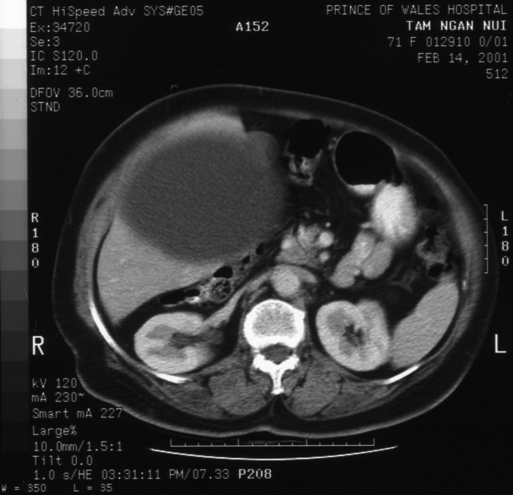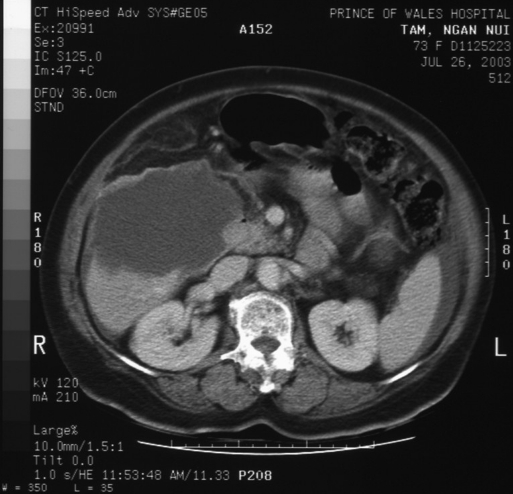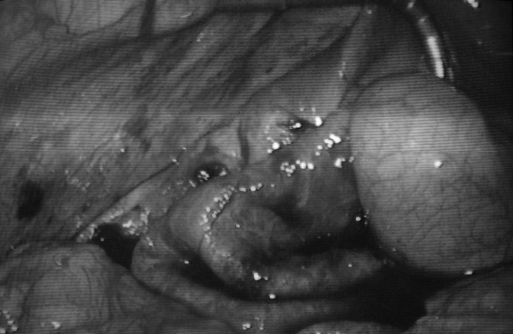Abstract
The use of laparoscopic techniques in the emergency treatment of liver cyst complications has not been reported in the literature. Laparoscopic surgery is a well-established treatment modality for giant hepatic cyst in the elective setting. We report a case of laparoscopic unroofing of a 15-cm ruptured hepatic cyst, which had recurred after previous percutaneous alcohol instillation therapy. Laparoscopic ultrasound was used to delineate the extent of the cyst while a Harmonic scalpel was used for dissection. The patient made an uneventful recovery and was discharged 4 days after the operation.
Keywords: Hepatic cyst, Ruptured, Laparoscopic unroofing
INTRODUCTION
Laparoscopic surgery is a well-established treatment modality for giant hepatic cysts, but this is rarely done in the emergency setting. We report a case of laparoscopic unroofing of a ruptured hepatic cyst, which had recurred after previous percutaneous alcohol instillation therapy.
CASE REPORT
A 73-year-old female was diagnosed with a simple hepatic cyst for 7 years. The cyst gradually increased in size to 17 cm (Figure 1). The patient had dull abdominal pain and early satiety. Physical examination revealed an enlarged, palpable right lobe of the liver. Percutaneous drainage with alcohol instillation had been performed in 2001. However, 3 months afterwards, the cyst recurred and rapidly increased in size to 15 cm. The patient was asymptomatic and was followed up in our clinic. She was admitted in July 2003 for severe abdominal pain and fever. Physical examination revealed generalized peritonitis. The previously palpable liver was no longer palpable. An urgent CT scan showed a ruptured hepatic cyst with fluid content extending to the hepatorenal fossa and free peritoneal cavity (Figure 2).
Figure 1.
A 17 cm cyst over the anterioinferior aspect of the right lobe of liver. There is no solid component or septation.
Figure 2.
The liver cyst has an irregular wall and extends to the hepatorenal fossa. Free peritoneal fluid is present.
Emergency laparoscopy was performed. Four ports were inserted. Two 10-mm ports were inserted over the umbilicus and epigastric area. In addition, two 5-mm subcostal ports were inserted over the midclavicular and anterior axillary line.
Laparoscopic examination found a partially collapsed hepatic cyst just lateral to the gallbladder fossa. In the peritoneal cavity, 500 mL of blood stained fluid was present (Figure 3). The size of the hepatic cyst was determined with the aid of laparoscopic ultrasound. The cyst was unroofed with a Harmonic scalpel and diathermy. Titanium clips were used to control large bleeds. The patient made an uneventful recovery and was discharged 4 days after the procedure. Her previous abdominal pain subsided after surgery, and she remained well on follow-up 3 months after the procedure.
Figure 3.
During laparoscopy, the collapsed liver cyst wall is seen, associated with brownish peritoneal fluid.
DISCUSSION
Simple hepatic cysts are found in 1.6% to 3.6% of people during ultrasound examination for other indications.1 The female-to-male ratio is 5:1. The majority of hepatic cysts are small in size, and less than 20% are more than 1 cm. Successive ultrasounds show that more than 80% of cysts detected do not increase in size. The majority of hepatic cysts are asymptomatic. Complications are rare unless the cysts reach a large size.2,3 Compression of the biliary tree, vascular compression, and intracystic hemorrhage rupture may occur in giant cysts. Reported ruptured liver cysts are usually >10 cm in size, but no incidence of rupture has been reported in the literature. Malignant change is extremely rare as the epithelium does not undergo active proliferation.
Various methods including percutanous radiological guided techniques, open surgery, and laparoscopic surgery have been reported to treat hepatic cysts with varying degrees of success.4,5 Percutanous sclerotherapy has a high initial success rate (80% to 100%) and has the advantage of not requiring general anesthesia. However, recurrence is not uncommon and infection and bile fistulation are potential severe complications.6,7
Open surgery with unroofing of cysts has been a standard treatment modality of giant hepatic cysts but laparoscopic management has emerged as a new, less-invasive therapeutic option.8,9 Nonparenchymal cyst walls are unroofed and cyst content is drained. The cyst edges are cauterized or secured by vascular staples. In this case, we used a Harmonic scalpel and titanium clips to secure hemostasis.
The feasibility of laparoscopic treatment depends on the location of the cysts. Cysts in upper segments and posterior segments are more difficult to access, and thus different port position and additional ports are required.10 At our center, we offer percutaneous alcohol injection for patients with symptomatic simple liver cysts that have no communication with the biliary system. Surgery is reserved for those with communication with the biliary system or those that recur after percutaneous therapy.
Rupture of liver cysts may be preceded by hemorrhage, which would increase the tension inside the cyst. Because the partially collapsed cyst would make the line of resection less obvious on laparoscopic examination, the exposure of the cyst may become difficult. Laparoscopic ultra-sound would be a useful adjunct to define the boundaries of the cyst.11
CONCLUSION
Laparoscopic unroofing is a feasible method for treatment of ruptured giant hepatic cysts in the emergency setting. Access trauma as a result of open surgery can thus be avoided.
Footnotes
Presented as a poster in the 6th Asia Pacific Congress of Endoscopic Surgery (ELSA 2003), Kuala Lumpur, Malaysia, September 10 –13, 2003.
References:
- 1. Caremani M, Vincenti A, Benci A, Sassoli S, Tacconi D. Echographic epidemiology of non-parasitic hepatic cysts. J Clin Ultrasound. 1993;21:115–118 [DOI] [PubMed] [Google Scholar]
- 2. Ishikawa H, Uchida S, Yokokura Y, et al. Nonparasitic solitary huge liver cysts causing intracystic hemorrhage or obstructive jaundice. J Hepatobiliary Pancreat Sug. 2002;9:764–768 [DOI] [PubMed] [Google Scholar]
- 3. Akriviadis EA, Steindel H, Ralls P, Redeker AG. Spontaneous rupture of nonparasitic cyst of the liver. Gastroenterology. 1989; 97:213–215 [DOI] [PubMed] [Google Scholar]
- 4. Simonetti G, Profili S, Sergiacomi GL. Percutaneous treatment of hepatic cysts by aspiration and sclerotherapy. Am J Roentgenol. 1983;141:559–560 [DOI] [PubMed] [Google Scholar]
- 5. Hansman MF, Ryan JA, Jr., Holmes JH, 4th, et al. Management and long-term follow-up of hepatic cysts. Am J Surg. 2001;181:404–410 [DOI] [PubMed] [Google Scholar]
- 6. vanSonnenberg E, Wroblicka JT, D'Agostino HB, et al. Symptomatic hepatic cysts: percutaneous drainage and sclerosis. Radiology. 1994;190:387–392 [DOI] [PubMed] [Google Scholar]
- 7. Montorsi M, Torzilli G, Fumagalli U, et al. Percutaneous alcohol sclerotherapy of a simple hepatic cyst. Results from a multicentre survey in Italy. HBP Surg. 1994;8:89–94 [DOI] [PMC free article] [PubMed] [Google Scholar]
- 8. Cappellani A, Zanghi A, Di Vita M, Menzo EL, Conti P. Nonparasitic cysts of the liver: laparoscopic treatment and long-term results. Ann Ital Chir. 2002;73:85–88 [PubMed] [Google Scholar]
- 9. Zacherl J, Scheuba C, Imhof M, Fugger R. Long-term results after laparoscopic unroofing of solitary symptomatic congenital liver cysts. Surg Endosc. 2000;14:59–62 [DOI] [PubMed] [Google Scholar]
- 10. Gigot JF, Legrand M, Hubens G, et al. Laparoscopic treatment of nonparasitic liver cysts: adequate selection of patients and surgical technique. World J Surg. 1996;20:556–561 [DOI] [PubMed] [Google Scholar]
- 11. Schachter P, Sorin V, Avni Y, et al. The role of laparoscopic ultrasound in the minimally invasive management of symptomatic hepatic cysts. Surg Endosc. 2001;15:364–367 [DOI] [PubMed] [Google Scholar]





